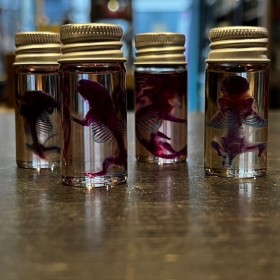
Anatomic lithography: "L'Anatomie de L'Homme" by Bourgery...
Anatomic lithography: "Traité complet de l'Anatomie de l'Homme"
by Dr Bourgery and draughtsman Jacob
1866







Diaphany of common mouse in jar
Biological preparation
Diaphany of common mouse in jar - Mus musculus.
The purpose of diaphanisation is to make the mouse transparent so that the skeleton can be seen through the skin.
The skin is made transparent by a chemical process, and specific dyes are used to highlight the skeleton.
This is mainly used for animals that are too small to be prepared for osteology in the conventional way or to study ossification sequences for example.
The vial in which it is contained is about 5cm high and 2.2 cm in diameter.
The vial does not contain formalin, as the fixation of the specimens is carried out before the preparation.
The specimens are then kept in these vials filled with pure glycerine which has the function of preserving the tissues. Some thymol crystals were added to the preparation as well to fight against mould.
The animals have not been killed for this purpose, they are sold as animal feed.
All specimens are different
Anatomic lithography: "Traité complet de l'Anatomie de l'Homme"
by Dr Bourgery and draughtsman Jacob
1866
Wall decoration of Pompeii - Herculaneum mosaics: Chromolithographic plate
By Wilhelm Zahn
Published between 1832 and 1849
Brown lace sea fan on a base
Brown Whip Coral
184: Helleborus orientalis - Lenten Rose
Real framed and calligraphed Herbarium
Hermit crab in it's shell under glass bell jar
Dardanus megistos from Indo-Pacific zone
Dinosaur tooth fossil: Mosasaurus
66 million years old
Provenance: Sidi Daoui (Morocco)
Ball of Lapis-Lazuli from Afghanistan
Ref: Y94
Shark tooth fossil
Otodus Obliquus dating from the Ypresian: 50 million years ago
Dia de la Muerte - Memento Mori
Sculpture on buffalo bone
Memento Mori sculpted from a deck of cards - Poker
Size S
RED color
Steampunk Flight of butterflies Napeocles Jucunda et Salamis Parhassus
Blacktip shark jaws - Carcharhinus limbatus
18/20cm
Plant fossil: Pecopteris Fern - 300 million years old
From the Carboniferous of Lorraine
Bi-Face skull - Half face and half skeleton
Carving on deer antlers - Memento Mori
Flight of butterflies: Heliconius family under glass dome
168: Hydrangea arborescens Annabelle
Real framed and calligraphed Herbarium

Diaphany of common mouse in jar
Biological preparation






